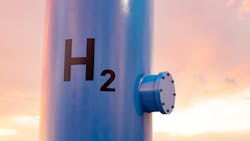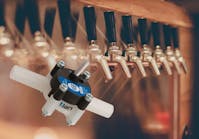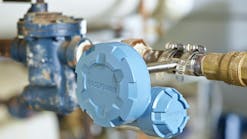Why smart measurement is instrumental to the green hydrogen revolution
The realization of the importance of shifting from fossil fuels, both for environmental and energy security reasons, is seeing growing interest in the use of green hydrogen as a sustainable fuel source. In this article, ABB's Cornelia Huber highlights the important role that smart instruments and analyzers play in optimizing efficiency and safety during the key stages of the green hydrogen production process.
The geopolitical, security and environmental factors affecting the generation and distribution of fossil-based energy sources are providing the impetus for countries worldwide to accelerate the development of alternative fuel sources such as hydrogen. Even before the start of 2022, the use of hydrogen as a potential fuel source was being considered as a key way of achieving the target of net zero carbon emissions by 2050 set by the Paris Agreement. Offering many of the advantages of both renewable energy and fossil fuels, hydrogen can be produced with low or zero emissions using wind, solar or hydropower and can be readily stored and transported. As a clean burning fuel, it produces only water as a by-product.
Developments in electrolysis technology and the falling cost of renewable energy resources are seeing a rising interest in the potential of "green hydrogen" as a clean and sustainable form of fuel production. An estimate by Frost and Sullivan projected that global hydrogen production was set to more than double in the decade between 2020 and 2030, from 71 million tons to 168 tons. Projections beyond 2030 also point to a further increase as production technologies become more efficient and production costs fall.
Producing green hydrogen
Key to the production of green hydrogen is the use of an electrolyzer to split water into hydrogen and oxygen, with the necessary power for the electrolysis process provided by renewable sources such as wind, solar or hydroelectric power.
Carrying out electrolysis on the sort of scale needed to provide the quantities of hydrogen needed to satsify mass energy demand presents several challenges that need to be addressed, including the combined need to maintain safe operation optimize the power to hydrogen conversion, and maximize the quality and purity of the produced hydrogen.
Smart measurement makes the difference
As in any industrial process, gauging performance and identifying potential areas for improvements in the green hydrogen production process relies on measuring multiple parameters as extensively as possible and using the resulting data to inform decision-making.
Today’s smart digital measurement technologies provide greater accuracy, range and depth of information that can be used to assess both process performance and the status of the measurement devices themselves, especially important in preventing unexpected problems such as faults or failures in safety-critical applications.
The inclusion of features such as remote connectivity also helps to make diagnostics information more usable, with engineers able to perform actions such as fault tracing or changes to an instrument’s configuration without having to be physically present. Greater predictivity also facilitates proactive maintenance, allowing process problems to be resolved before they escalate, avoiding unnecessary downtime and minimizing the risk of potential damage to key process plant or impaired hydrogen quality.
Digital instruments also offer enhanced simplicity, making it easier for operators at any level of experience to access or relay key operational and maintenance-related data using commercially available technologies. An example is the use of QR codes, which can be scanned using a smartphone or tablet to enable data to be sent about the instrument to its manufacturer who can then offer remote assistance to change a setting or fix a fault.
Keeping production up to standard
As a multi-stage process, green hydrogen production requires accurate measurement of a variety of parameters to ensure safe and efficient operation. ISO22734:2019 stipulates the main parameters that need to be measured throughout the various stages of the production process to help maintain control and avoid potential issues that could affect efficiency or safety.
Keeping an eye on gas quality
At their simplest level, electrolyzers produce oxygen at the anode and hydrogen at the cathode. However, many reactions in the electrolyzer can cause small concentrations of oxygen to build up in the hydrogen stream and hydrogen to build up in the oxygen. This is a fault condition and must be detected by appropriate instruments that can be used as part of an automated safety system that can initiate actions in the event of an oxy-fuel gas mixing alarm being activated.
A solution is to use a gas analyzer with the sensitivity to detect very low levels of hydrogen and oxygen to. Options such as ABB’s Caldos27 thermal conductivity detector gas analyzer and Magnos28 paramagnetic oxygen analyzer can be used to measure both traces of hydrogen in the oxygen stream and traces of oxygen in the hydrogen stream.
The inclusion of QR code functionality also enables easy checking of the system configuration and the health of the analyzer, providing a further safeguard against potential problems.
Liquid level monitoring in the phase separator
After the electrolyzer, the raw hydorgen gas will contain both traces of oyxgen and residual electrolyte vapors from the electrolyzer cell. An intial knock-down phase separator will enable separation of the liquid and gas, after which the hydrogen is then cooled and passed to a second separation phase to remove the condensate.
The first separation occurs in a vertical vessel, with the hydrogen being vented from the top, while liquid from the base is pumped and recirculated to the electrolyzer. It is it crucial to monitor the water level in the knock-down phase separator as this process happens to prevent the risk of the pump running dry and the hydrogen entering the pump then flowing to the wrong part of the electrolyzer. The level measurement solution should enable the system to react to low and very low level conditions, either tripping the recirculation pump or shutting down the electrolyzer and initiating a nitrgen gas purge.
It is important to use a device that can safely measure level and be able to withstand obstacles including high pressures and temperatures as well as the risk of corrosion, all three of which can occur in hydrogen applications. One solution is to use magnetic level instruments, including magnetic switches and sensors to measure low and high levels in the phase separator. By isolating the device from the process medium, magnetic level measurement offers an ideal non-contact solution for measuring levels in the phase separator, while also eliminating the need for costly seals, diaphragms, and process connections commonly associated with point level switch technology. Set points can be adjusted without any changes to process piping, resulting in level switches that are quickly deployed, readily adjustable and easy to maintain.
Safeguarding against electrolyzer overheating
The variable nature of renewable power sources such as solar and wind means there is a possibility that a sudden surge in available electricity may cause the electrolyzer to ramp up the rate of hydropgen production. This will cause the current drawn by the electrolyzer to increase, causing the stack temperature to rise.
Continuously measuring the stack temperature will enable effective control of cooling to maintain levels within safe limits. This can be achieved by combining a platinum resistance thermometer with an appropriate transmitter to give a reliable temperature measurement and alarm solution. Where features such as continuous sensor monitoring and self-monitoring are also included, there is the added possibility of gathering additional information about supply voltage and issues such as wire breaks or corrosion.
The same solution can also be applied to monitor and control temperatures in at the de-oxo stage, where traces of oxygen in the hydrogen are converted to water in an exothermic catalytic reaction to create the final hydrogen product. At this stage, it is essential to monitor the temperature to ensure that the reaction remains under control and that conditions remain within safe limits.
Maintaining safe electrolyzer pressure control
Some types of electrolyzers are designed to operate at elevated pressure. The ability to accurately measure pressure levels is especially important if the gas is to be used at high pressure, as pumping the liquid water feed to the electrolyzer to an elevated pressure such as 30 bar is both less costly and much less energy intensive than compressing the hydrogen gas from atmospheric pressure to 30 bar after the electrolyzer. Installing a device such as ABB's 261GS digital pressure transmitter in the water circuit can help to ensure that pumping pressures are maintained.
Accurate and reliable pressure measurement is also important in maintaining process safety by preventing over-pressurization of the electrolyzer and ensuring that hydrogen and oxygen gases generated by the electrolyzer can flow away without obstruction.
Measuring the pressure of oxygen and hydrogen gases can be achieved by using ABB’s 266GST and PGS100 series pressure transmitters. Both are certified by TUV NORD for use in process safety control systems according to the IEC61508 standards series on functional safety and meet the requirements for SIL2 applications when specified with a single transmitter configuration and for SIL3 applications when a redundant configuration is chosen, making them ideally suited for protecting pressurized electrolyzers.
Another issue that can affect pressure transmitters in hydrogen applications is the problem of hydrogen permeation. In certain conditions, hydrogen molecules can pass through the pressure transmitter diaphragm. As the hydrogen accumulates, it slowly diffuses into the pressure transmitter’s fill fluid, changing its behaviour and impairing transmitter performance until failure occurs.
A solution is ABB’s ‘H-Shield’ titanium-based binary nano coating. With its tight molecular structure, H-Shield provides the highest resistance against hydrogen ion permeation, whilst still enabling the diaphragm to respond to changing pressure conditions.
The green hydrogen revolution begins with measurement
As a way of optimizing process performance, the latest generation of measurement instruments and analyzers are already playing a major role in realizing the potential of green hydrogen as a plentiful and sustainable energy source. When used to their full extent, the expanded capabilities offered by today’s smart instruments can bring real benefits by, maximizing efficiency and safety and providing fast access to detailed data to inform decision making.
Cornelia Huber | Global Head of Communications and Marketing for Instrumentation at ABB
Cornelia Huber is the Global Head of Communications and Marketing for Instrumentation at ABB.




